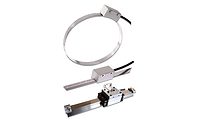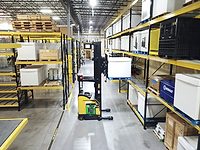Last year, sales of automated guided vehicles (AGVs) were the highest since pre-Recession years, according to the Automatic Guided Vehicle Systems (AGVS) Industry Group of the Material Handling Industry of America (MHIA). From 2007 to 2011, the number of vehicles purchased increased 70 percent, the group reported. Furthermore, demand for AGVs from the beverage industry has increased. In 2011, beverage and tobacco manufacturing both moved into the No. 3 spot for industries with the greatest demand for AGVs, preceded by transportation and food manufacturing, according to the group.
AGVs offer multiple benefits for beverage facilities, including reduction in labor and operating costs through more cost-effective product handling, increased productivity and better quality assurance, says Scott Kwilinski, director of solutions engineering for Egemin Automation Inc., Holland, Mich.
“Some of the less obvious benefits of AGVs are reducing the amount of missing or damaged product, reduction in equipment damage, which results in increased equipment life expectancies, gains in inventory traceability and record keeping, a safer operating facility, and a more clean and orderly facility that makes quite a showroom for the company,” he says.
Flexibility also is key when it comes to AGVs. For instance, Chalfont, Pa.-based John Bean Technologies (JBT) Corp. worked with a Tropicana distribution center in Jersey City, N.J., part of PepsiCo’s North America Beverages unit, to improve efficiency and increase order accuracy. JBT Corp.’s forked AGVs use laser guidance to transport pallets of refrigerated goods from discharge conveyors to trailers. The vehicles are managed by software that coordinates all communication to support vehicle operation. Because the distribution center services the New York metropolitan area, the AGV system had to be able to load narrow customer-owned city trailers that varied in width with roll-up doors instead of the industry standard wide trailers with outside hinge doors. To accommodate this demand, the AGV system needed to be highly flexible in order to successfully load the variety of trailer configurations, the company says.
Flexibility, redundancy and expandability are some of the main logistics trends relating to AGVs, says Scott Hinke, AGV general business vice president for Dematic Corp., Grand Rapids, Mich.
“AGVs can be easily reconfigured to operate differently within a distribution center and then more vehicles can be added to the solution as the volumes increase,” Hinke says. “That flexibility fits really well into the beverage space because you’ve had SKU proliferation and you have a lot of seasonal-type demands in the beverage space, and AGVs can be easily adaptable to all those situations.”
Vision systems also offer flexibility for AGVs. Laser guidance and vision guidance, in particular, offer flexibility in setting up a warehouse because they enable operators to modify or change the layout of the warehouse, says Brad Moore, vice president of AGV pick and global accounts for Swisslog, Buchs, Switzerland. Magnetic tape also enables modifications to guide paths, experts say.
In recent years, AGVs have made advances in more accurate and longer range sensors, which have enabled greater product density, Egemin’s Kwilinski says. Additionally, advances in evaluating and identifying product as well as enhancements to safety systems have allowed AGVs to support new areas within a facility, he says. Some AGV systems now can be integrated with warehouse management systems (WMS), which support warehouse automation from the end of the production line to the truck, he adds.
Expanding into new areas
Egemin specializes in automated systems that utilize AGVs designed for end-of-line production, warehousing or trailer-loading solutions, which is an emerging area of operation for AGVs.
Last year, manufacturing accounted for 75 percent of all AGV systems and distribution center operations accounted for the remaining 25 percent, said Randy Winger of Dematic and vice chair of the AGVS Industry Group of the MHIA, in a statement.
“There is a shift under way as AGVs expand increasingly into distribution centers,” Winger said. “In fact, the number of distribution center applications increased 50 percent since last year and seven times compared to 2007. The flexibility and scalability of AGVs make them an attractive choice for warehouses and distribution centers.”
Affordability and labor reduction are other reasons for the expansion of AGVs, says Sarah Carlson, marketing director for Farmington Hills, Mich.-based Daifuku Webb. AGVs now are more affordable than ever, she says. As an example, she notes the company’s popular SmartCarts automatic guided carts, which can carry loads up to 6,000 pounds. They are very cost effective, easy to implement and guided by magnetic tape, she says. They also feature a human machine interface (HMI) display where operators can receive information about the vehicle’s performance and battery life, she adds. Systems interfaced with a WMS also have the ability to run reports on the system’s performance, she says.
Safety first
These advances, coupled with improved safety features, make up some of the largest recent changes for AGVs, Carlson says. To improve safety, laser bumpers were developed to enable the AGVs to stop and slow down more quickly as well as operate in tighter areas, she says.
“In the past, AGVs have always had mechanical bumpers, and the mechanical bumpers were in themselves a limitation because the vehicle then would have this device that would have to be so long to allow it to make contact with a person, a truck, anything in the building, and then stop within a distance of that collapsed bumper,” Swisslog’s Moore explains. “With the laser sensors, there’s no mechanical device that gets unwieldy when it gets larger.”
OCME America Corp., Fort Lauderdale, Fla., cites a 2006 study by the U.S. Occupational Safety & Health Administration, which reported that 96,700 workers are involved in lift-truck accidents each year. Statistics also report cases of fatal accidents occurring during vehicle recharging, OCME states. AGVs run on batteries that oftentimes can be changed by other AGVs, experts say, thus reducing accidents.
OCME offers its Auriga series of laser-guided AGVs with loading capacities between 3,306 and 9,920 pounds. The models in the Auriga line can be fitted with forks, on-board roller or chain conveyors and with special gripping devices to handle specific types of products. The company also features a lifting vehicle and conveyor-equipped vehicles. Each handles between one and eight pallets, the company says.
Egemin offers very narrow aisle, high reach, trailer loading, standard fork and custom AGV solutions, which can utilize laser, inertial or wire guidance, Kwilinski says. Furthermore, the company offers a WMS solution that is aimed at automation. This leads to further reduced handling costs, improved traceability, less product damage and increased flexibility, he says.
In addition to its SmartCart, Daifuku Webb offers forked vehicles, tuggers, unit load handling and roller conveyors, which are either inertial or laser guided, Carlson says. It also offers trailer loading and unloading vehicles, which are becoming more common, she says.
Similarly, JBT Corp. has experienced success with trailer-unloading, which is quite a bit more difficult than trailer loading because product can shift during the trip, says Mark Fung, industry sales manager for food and beverage at JBT Corp.
Merging technologies
JBT Corp. also offers laser-guided fork-style, clamp-style, roll-clamp and flat-table conveyor-type AGVs as well as dual-navigation systems, which is a recent innovation.
“Previously, AGVs in warehouses were limited by their laser guidance targets being mounted on existing building columns,” Fung explains. “Depending on product height, these targets could be easily obscured when the vehicles were stacking products in a lane or going into drive in rack. Additionally, traditional laser navigation is not available when the AGV is loading pallets into an over-the-road trailer.” Dual navigation uses laser navigation as its primary guidance, but adds another method such as wire or magnetic tape to compensate for times when the laser navigation is not available, he adds.
Dematic supplements its AGVs with voice picking software under the FlexTruck Voice name. This hybrid solution assists with the picking process, improving productivity between 30 and 60 percent, Hinke says. Instead of a manual picker using voice technology to pick cases, place them on a walkie rider, drive the vehicle to the next location and repeat the process, the AGV can collaborate with the software to automatically travel where it’s needed, saving the operator time. Dematic also offers laser- or inertial-guided tugger-type AGVs, unit load handling AGVs and forked applications, which currently are most popularly used in beverage facilities, Hinke says.
“[AGVs have] been a technology that’s been used for a lot of full pallet handling as far as taking things from manufacturing to the warehouse and even for full pallet handling within larger distribution centers,” Hinke says. “The trend that we’re trying to solve in the beverage industry with our solutions is how [we can] utilize AGV technology to improve the case picking aspects of a distribution center because that’s really where all the labor is. Combining AGVs with other technologies and coming up with solutions we believe is the key to success in the next round of automation.”
Swisslog also offers an AGV with voice interface called AGVPick. It is a laser-guided pallet truck AGV that is used for order filling and can handle up to three pallets at a time, Moore says. The company’s AGVTransport uses the same vehicle to transport product from production to shipping or from production to the warehouse, he adds.
“Any time you can utilize an AGV in a repetitive environment that would normally be done with productive labor, you’ll get a good return on investment on those AGVs,” Moore says. He also notes that using AGVs for order filling tasks will become more popular in the future.
Categorized as an automated lift truck, Raymond lift trucks from The Raymond Corp., Greene, N.Y., in collaboration with Seegrid Corp., Pittsburgh, enable man-on and man-off automated functionality. When the trucks operate automatically, they are guided by Seegrid vision technology. Raymond lift trucks can learn up to 15 miles of routes in unlimited configurations in just a few hours, the company says.
“With a vision guided system, that basically enables you to program routes and use those same routes in the same day,” says Chris Cella, president of Heubel Material Handling Inc., a Raymond sales and service center based in Kansas City, Mo. “… What’s really great about the automated lift truck is you could bring one on site and be using it within a couple of hours to actually do work.”
The company’s center rider pallet truck can handle one or two pallets, while the tow tractor can move multiple loads up to 10,000 pounds, Cella says. One operator can manage as many as five vehicles at a time, increasing labor productivity.
“In the next 10 years, automation in the warehouse will be standard and warehouses will begin to be designed with automation in mind,” Egemin’s Kwilinski says. “A fully integrated AGV managed warehouse will be the accepted solution.” BI









